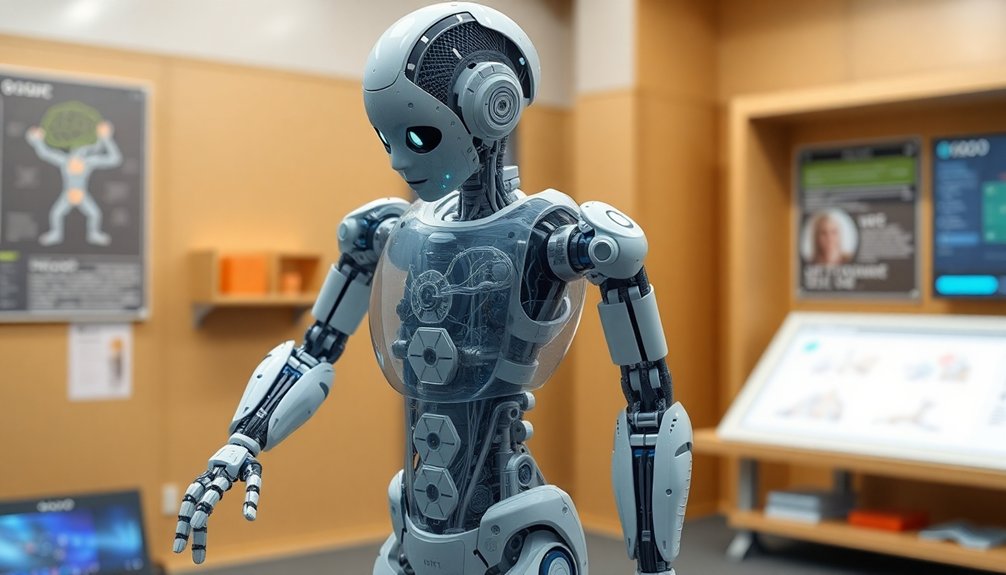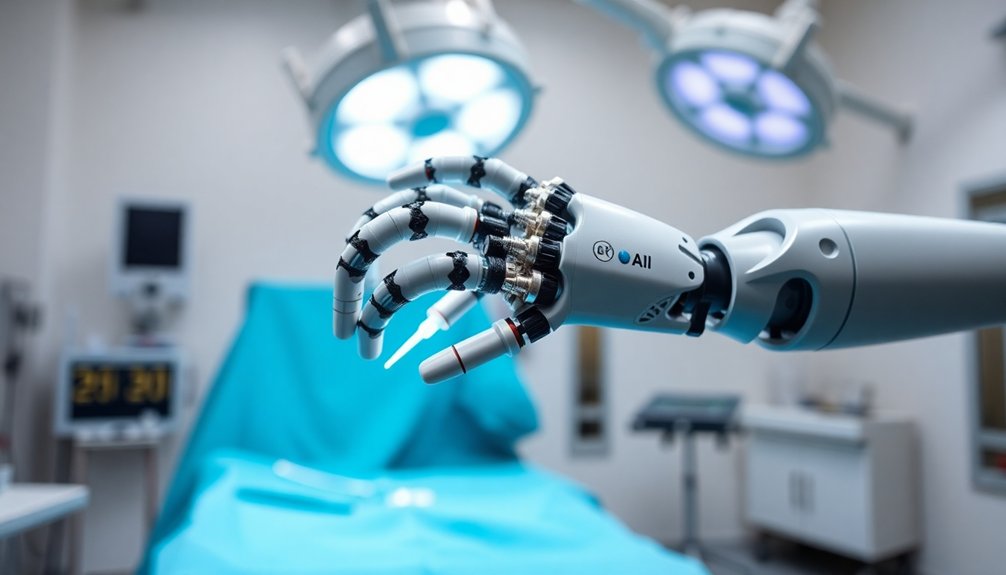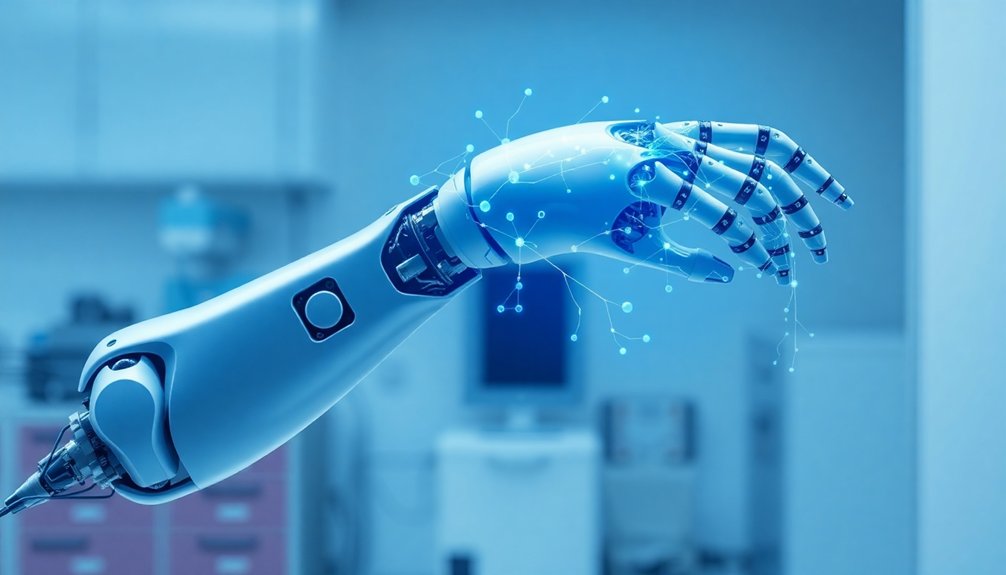Robots aren’t just code anymore—they’re learning machines that need both brains and bodies to truly understand our world. Imagine a robot that doesn’t just calculate, but feels and adapts like you do. Embodied AI lets machines experience reality through movement, sensors, and real-time learning. They’re evolving from rigid programs to dynamic explorers, traversing complex environments with increasing sophistication. Curious about how they’re reshaping our future? Stick around.
What Is Embodied AI and Why Does It Matter?

While traditional AI might feel like a brainy computer crunching numbers in a sterile lab, embodied AI is something else entirely.
It’s about robots and intelligent systems that don’t just compute — they physically interact with their environment. Think of embodied AI as learning through doing, not just analyzing data. These smart systems develop sensorimotor intelligence by moving, sensing, and adapting in real-world scenarios.
Unlike traditional AI’s static learning models, embodied AI can navigate unpredictable spaces, adjust to different challenges, and learn from actual experiences. Depth estimation techniques enable robots to understand complex 3D environments and make split-second decisions for smooth navigation.
Embodied AI dynamically learns by exploring, adapting, and experiencing the world in real-time, beyond rigid computational boundaries.
Sure, there’s the Sim2Real gap that makes shifting from simulated to physical worlds tricky. But that’s what makes embodied AI so fascinating: it’s not just about processing information, it’s about truly understanding and responding to the world around it. Cool, right?
How Physical Embodiment Transforms Artificial Intelligence
When you think about AI, forget those lifeless algorithms stuck in computer screens. Physical embodiment transforms artificial intelligence from passive data processors to dynamic learners. Embodied AI isn’t just code—it’s intelligence with a body that learns through real-world interaction. Humanoid robotic systems are pioneering a breakthrough in understanding how physical interaction fundamentally reshapes machine learning capabilities.
| Sensory Input | Learning Mechanism | Adaptability |
|---|---|---|
| Vision | Multimodal Learning | Complex Task Exploration |
| Touch | Feedback Loops | Environmental Adjustment |
| Sound | Neural Mapping | Responsive Behavior |
Imagine humanoid robots that don’t just compute, but explore and understand environments like curious toddlers. By integrating sensory inputs and machine learning, these systems develop unprecedented adaptability. They’re not just programmed; they’re evolving. From manufacturing robots exploring factory floors to service machines understanding natural language, embodied AI represents the next quantum leap in artificial intelligence—where smart machines don’t just calculate, they experience.
Real-World Applications Driving the Embodied AI Revolution

From abstract algorithms to robots roaming real-world spaces, embodied AI isn’t just a tech fantasy—it’s happening right now.
Imagine robots like Spot crawling through dangerous industrial sites, or Pepper greeting customers with uncanny social skills. These multimodal systems aren’t just programmed; they physically learn and adapt.
Autonomous vehicles like Waymo’s self-driving cars prove how AI can navigate complex environments by combining sensory inputs with real-time intelligence.
AI-powered vehicles dynamically map and navigate intricate landscapes through intelligent, adaptive sensory processing.
Humanoid robots are revolutionizing sectors from healthcare to manufacturing, showing that embodied AI isn’t about replacing humans, but extending our capabilities.
These physical machines don’t just compute—they interact, sense, and solve tasks in ways traditional software never could.
Want to see the future? Watch how these robots transform from clunky machines to intuitive, intelligent companions. Humanoid companionship technology is rapidly evolving, with advanced robots now capable of providing emotional support and learning from human interactions.
Challenges and Breakthroughs in Robotic Intelligence
Bridging the Sim2Real gap means teaching machines to handle messy, unpredictable real-world scenarios through learning through interaction. Large models and neural networks are revolutionizing robotic systems, but a physical body remains essential for embodied intelligence. Neuromorphic computing is transforming machine learning by mimicking brain-like processing, enabling more adaptive and energy-efficient robotic systems.
Think of it like growing up: you can’t understand gravity by reading about it, you’ve got to fall down a few times. Interdisciplinary collaboration is cracking this code, helping robots adapt faster and smarter.
The key? Turning trial and error into a superpower. Can robots become more than sophisticated appliances? With breakthroughs in adaptability, they’re getting closer to thinking and moving like living creatures.
The Future of Intelligent Machines: Beyond Traditional Boundaries

As intelligent machines break free from their traditional programming constraints, the future of embodied AI looks less like a sci-fi fantasy and more like an imminent reality. Humanoid robots are pioneering this transformative approach by combining sophisticated control systems with bipedal movement. You’ll witness humanoid robots seamlessly integrate learning across multiple domains, transforming how we perceive machine intelligence. Imagine robots that don’t just compute, but actually experience the world through multimodal sensory inputs — seeing, hearing, and feeling their environment in real-world contexts. These aren’t just machines; they’re adaptive systems that learn and evolve beyond rigid algorithms. By combining advanced AI capabilities with physical embodiment, we’re creating robots that can navigate complex challenges with unprecedented flexibility. Want proof? Look at how companies like Tesla and Agility Robotics are already pushing boundaries, turning once-impossible robotic interactions into everyday possibilities.
People Also Ask About Robots
Why Embodied AI Is Important?
You’ll need embodied AI because it learns dynamically through real-world interactions, enabling robots to adapt, navigate complex environments, and solve problems more intelligently than traditional AI systems by experiencing sensory feedback.
Why Is AI Called the Brain of Robots?
You’ll see AI acts as a robot’s brain because it processes information, makes decisions, and controls actions, enabling the machine to learn, adapt, and respond intelligently to complex environmental challenges through advanced algorithms and sensory interpretation.
What Is the Difference Between the Human Brain and the Robot Brain?
You’ll find that a human brain learns dynamically through experiences, while a robot brain relies on algorithms and pre-programmed data, lacking the emotional depth and adaptive neural plasticity of biological intelligence.
Why Is Artificial Intelligence Important for Using Robots to Move Real Objects?
Imagine a robot learning to catch a ball like a child—you’ll see AI’s magic. It’s essential because AI enables robots to adapt, learn from mistakes, and intelligently manipulate objects in unpredictable environments through continuous, dynamic sensing.
Why This Matters in Robotics
Robots aren’t just sci-fi fantasies anymore. They’re becoming smarter by learning through physical interaction, just like humans do. You’ll see machines that adapt, sense, and respond in ways we never imagined. The boundary between artificial and natural intelligence is blurring fast. Will these embodied AIs be our partners or competitors? One thing’s certain: the robots of tomorrow won’t just think — they’ll truly experience the world around them.
